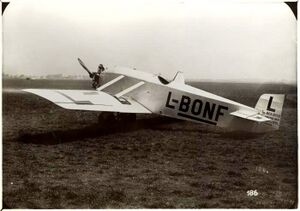Engineering:Avia BH-9
| BH-9 | |
|---|---|

| |
| Role | Sports plane |
| Manufacturer | Avia |
| Designer | Pavel Beneš and Miroslav Hajn |
| First flight | 25 November 1923 |
| Introduction | 1923 |
| Number built | 11 |
The Avia BH-9 was a twin-seat sports plane built in Czechoslovakia in 1923, based on the BH-5. As with other developments in the BH-1 lineage, the BH-9 was a low-wing braced monoplane that accommodated the pilot and passenger in tandem, open cockpits. The BH-9's structure was strengthened to allow the use of a higher-power engine than in its predecessors, and for the first time, this was a domestically-produced powerplant. Although built as a twin-seat aircraft at least one (registration L-BONF - see picture) was converted to a single-seater.
The Czechoslovakian Army showed interest in it as a trainer and liaison aircraft, and ordered ten examples under the designation B.9.
A B.9 won the 1925 Coppa d'Italia air race, and the following year, one was flown on a 1,800 km (1,100 mi) circuit Prague-Paris-Prague with an average speed of 131.2 km/h (82 mph).
Specifications
General characteristics
- Crew: one pilot
- Capacity: one passenger
- Length: 6.64 m (21 ft 10 in)
- Wingspan: 9.72 m (31 ft 11 in)
- Height: 2.53 m (8 ft 3 in)
- Wing area: 13.6 m2 (146 sq ft)
- Empty weight: 345 kg (761 lb)
- Gross weight: 550 kg (1,213 lb)
- Powerplant: 1 × Walter NZ 60 radial , 45 kW (60 hp)
Performance
- Maximum speed: 158 km/h (98 mph, 85 kn)
- Range: 470 km (290 mi, 250 nmi)
- Service ceiling: 4,500 m (14,800 ft)
See also
Related development
References
- Taylor, Michael J. H. (1989). Jane's Encyclopedia of Aviation. London: Studio Editions. pp. 86.
- World Aircraft Information Files. London: Bright Star Publishing. pp. File 889 Sheet 86.
- Němeček, V. (1968). Československá letadla. Praha: Naše Vojsko.
- airwar.ru
 |

